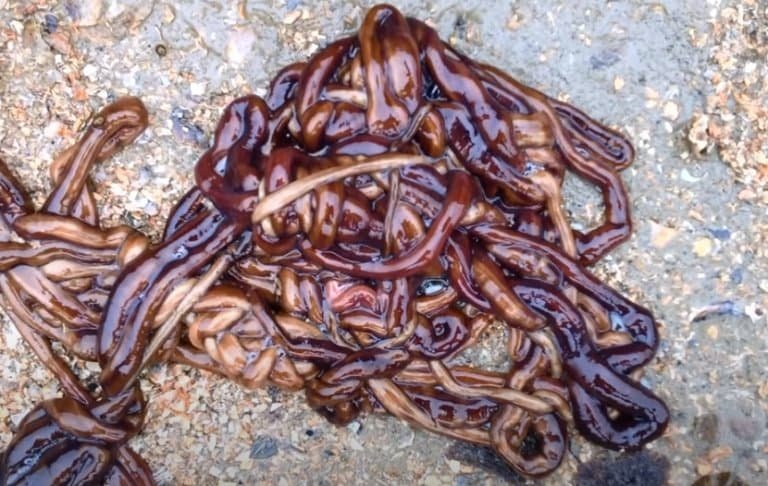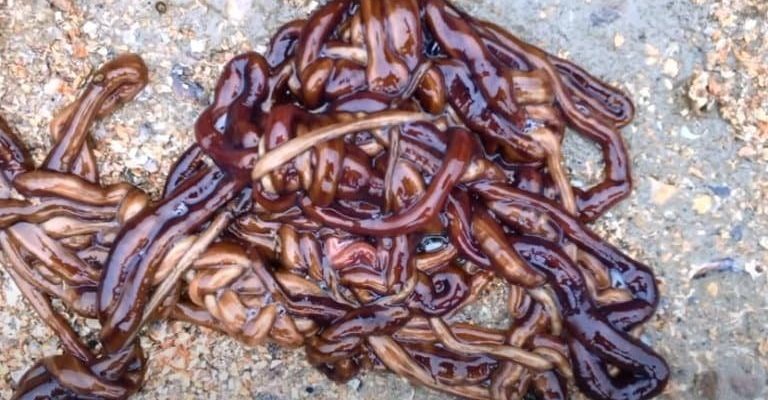
Imagine attending a party and finding a giant snake-like organism hiding under the buffet table. That’s kind of like spotting a bootlace worm in its natural habitat! Most of us will rarely, if ever, encounter one, but they play a crucial role in marine ecosystems. Let’s dive in and explore the fascinating world of bootlace worms, how they grow so long, and what makes them truly unique.
What Are Bootlace Worms?
Bootlace worms belong to a group called *Lineus*, and they’re a type of ribbon worm. Although they may look like simple elongated tubes, they’re actually surprisingly complex creatures. Found mainly in the waters around the British Isles and along the coasts of Europe, these worms thrive in shallow, muddy environments. Their bright colors can catch the eye, making them striking, albeit unusual, inhabitants of the sea.
These worms are known for their incredible length, but they’ll often coil up when threatened or disturbed. This might make them seem smaller than they really are. When fully extended, it’s as if they decided to stretch out and show off their length, making us all wonder how something so long can be hidden from our sight.
How Do Bootlace Worms Grow So Long?
You might be wondering how these worms achieve such impressive lengths. The secret lies in their unique biology. Bootlace worms grow in segments, a feature that allows them to regenerate lost body parts and keep growing throughout their lives. This means that instead of a fixed size like many animals, bootlace worms can continue to elongate as long as conditions are right.
In optimal environments, where there is plenty of food and minimal threats, these worms can grow to their full potential. Imagine a plant that keeps getting watered and fertilized—it just keeps getting bigger! This regeneration and growth can happen at a remarkable rate, allowing them to reach lengths that boggle the mind.
Feeding Habits of Bootlace Worms
Bootlace worms are predatory, feeding primarily on small crustaceans and other marine life. They possess a specialized structure called a proboscis, which they can extend to capture prey. This is where the worm’s incredible length comes into play. The longer the worm, the farther it can reach for food.
When they sense potential meals nearby, bootlace worms will shoot out their proboscis, aiming for unsuspecting creatures. It’s similar to how a chameleon shoots out its tongue to snag an insect. Their ability to stretch not only helps them capture food but also allows them to navigate their environment more effectively.
Reproduction and Life Cycle
The reproduction process of bootlace worms is as fascinating as their growth. They have both male and female reproductive organs, which means they can mate with other worms or self-fertilize. After mating, they lay eggs, which can develop into free-swimming larvae.
This stage is pretty remarkable—when the larvae hatch, they’re small and delicate. Over time, as these tiny creatures sink to the ocean floor and find suitable environments, they start to grow. The larvae undergo several molts, gradually transitioning into the familiar long, ribbon-like shape of the adult bootlace worm.
Where Do You Find Bootlace Worms?
You’ll most likely find bootlace worms on the seafloor in shallow coastal waters. They prefer habitats rich in organic material, like mud or sand, where they can burrow and hide. In some areas, they can be common, but due to their camouflage and flexible bodies, they often go unnoticed.
If you ever take a stroll on the beach, you might consider flipping over some rocks. However, exercise caution—you don’t want to disturb any bootlace worms, as they can be fragile. Plus, they have a few tricks up their sleeve, like the ability to break apart and regenerate if threatened.
Bootlace Worms vs. Other Marine Creatures
So how do bootlace worms stack up against other long animals, like the blue whale or giant squid? While those creatures are impressive for their size and mass, bootlace worms take the cake for sheer length. However, they don’t have the same massive body or intelligence as these ocean giants.
In fact, bootlace worms operate on a different level when it comes to survival. Instead of relying on size and strength, they use their agility, camouflage, and regenerative abilities to thrive in their environments. This makes them uniquely suited to their roles in the ecosystem, contributing to the diverse web of life in the ocean.
Why Bootlace Worms Matter
You might think, “What’s the big deal about bootlace worms?” Well, these creatures play a vital role in the ocean’s health. They help control populations of smaller marine animals, thus maintaining balance in their ecosystem. Plus, they serve as food for various predators, creating a connection in the food chain.
Studying bootlace worms can also provide insights into regeneration and resilience. Scientists are keen to understand how these creatures thrive despite the challenges of their environments, which could ultimately inspire advancements in medicine and biology for humans.
As you can see, bootlace worms might seem a bit odd, but they’re a prime example of the wonders of nature. Who knew a creature that can reach over 50 meters could teach us so much about life beneath the waves?
In summary, the bootlace worm is not just a curiosity; it’s a fantastic example of how diverse and complex marine life can be. Next time you think about the ocean, remember there’s a long, colorful worm swimming around, quietly playing its part in the grand tapestry of life below the surface.

